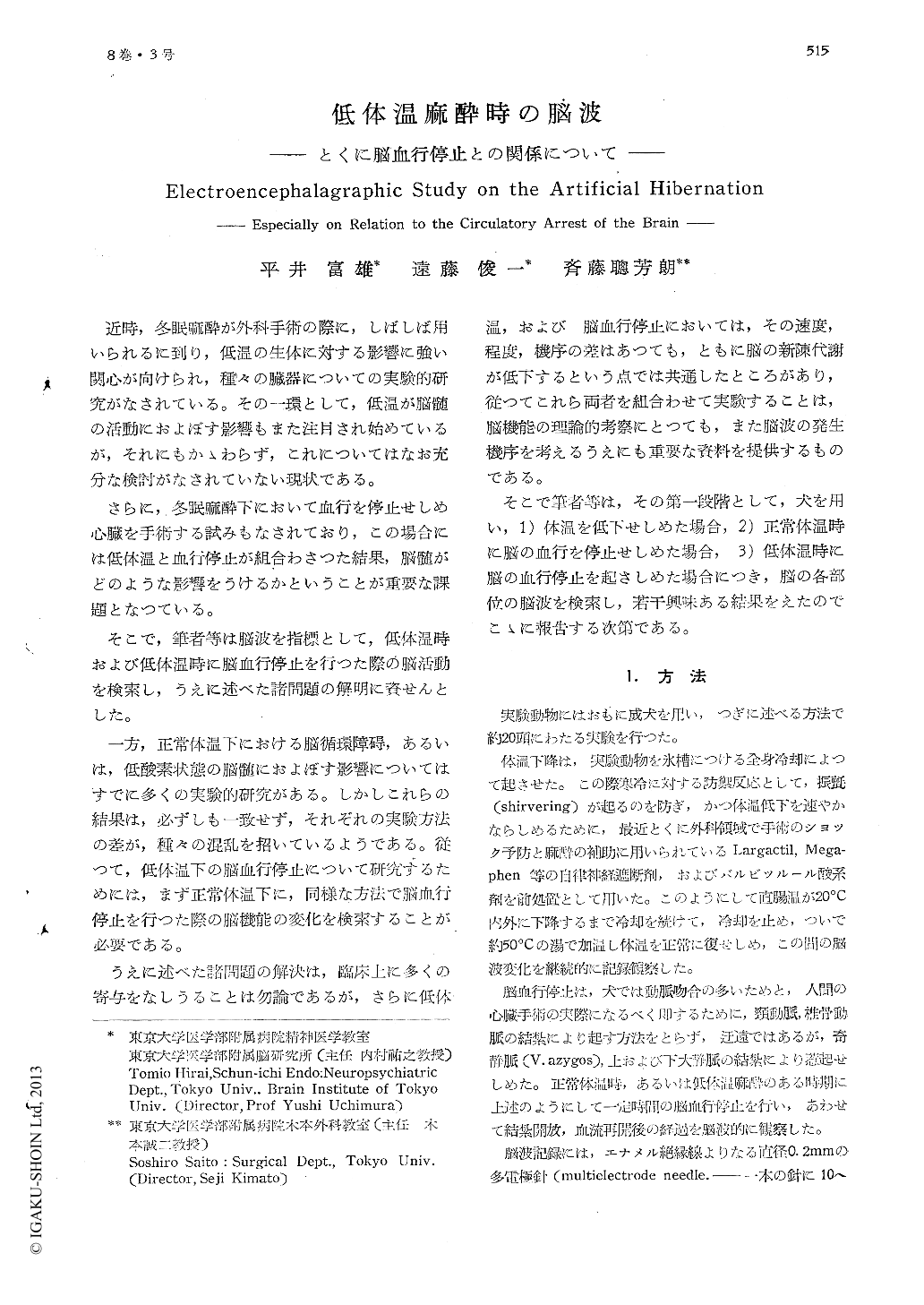Japanese
English
- 有料閲覧
- Abstract 文献概要
- 1ページ目 Look Inside
近時,冬眠麻酔が外科手術の際に,しばしば用いられるに到り,低温の生体に対する影響に強い関心が向けられ,種々の臓器についての実験的研究がなされている。その一環として,低温が脳髄の活動におよぼす影響もまた注目され始めているが,それにもかゝわらず,これについてはなお充分な検討がなされていない現状である。
さらに,冬眠麻酔下において血行を停止せしめ心臓を手術する試みもなされており,この場合には低体温と血行停止が組合わさつた結果,脳髄がどのような影響をうけるかということが重要な課題となつている。
Electrical activities of various parts of the brain (cerebral cortex, subcortical nuclei, cere-bellum and medulla) were studied at the course of the "artificial hibernation", examing the in-fluences of the circulatory arrest under low body temperature and normal one in the me-thod of EEG.
The results obtained with about 20 dogs, were as follows ;
1) EEGs showed only slight decrease in amplitude and frequency until the body tempera-ture of the animal became as low as 30℃. But it was when the body temperature was lower than 30℃ that the decrease of frequency and amplitude began to be remarkable. Thereafter these EEG changes progressed and the electri-cal activities of the various regions disappeared simultaneously under 20℃.
2) Thus disappeared EEGs could recover with the body temperature, electrocardiogram and spontaneous respiration ect., if the animals were rewarmed as instant as possible. In this pro-cess (low temperature→normal one) after body temperature had reached about 30℃ the re-covery on EEG was remarkalble. Under 30℃, only poorly organized pattern was shown on EEGs even at the same degree of temperature of the reverse process (normal temperature→ low one). Therefore, though the EEG changes at the hypothermia are reversible, it requires much more times than the recovery of the body temperature and other physiological parameters.
3) In the comparison with the general hypo-thermia, the brain cooling was performed. In these cases EEG changes did not differ from the above.
4) The differences of the circulatory arrest between normal and low body temperature, were as follows ; a) The time required of complete disappearing of EEGs after the onset of the circulatory arrest was within 1′30" in normal temperature, on the other hand in hypothermic condition, it was from 1′30" to 2′.
b) In normal body temperature, the longer the circulatory arrest continued, the slower any ele-ctrical activities reappeared after recovery of circulation. However, in hypothermic anesthesia this parallel relationship was not recognized be-cause of the various factors of experimenting conditions.
c) The maximum time of the circulatory ar-rest of the brain seems to be 5′in normal body temperature and from 10′to 15′in hypothermic state.
d) In some cases on which the circulatory arrest was performed in normal temperature, electrothalamogram persisted much longer than that of the other brain regions. But in hypo-thermic anesthesia EEGs of various parts of thebrain disappeared almost simultaneously after the onset of the circulatory arrest.
5) The findings which suggest us the probable histopathological changes in brain tissues were obtained in several cases after this opera-tion.
6) The disterbances on the brain caused by the circulatory arrest under the hypothermia, will be decided by next "function".
f 〔F2, (A-F1)〕
Here, A represents the lack oxygen, F2, the disterbance of brain metabolism by hypothermia and F1, the diminution of oxygen consumption.
If this "function" would be off the certain limit the irreversible changes will appear in the brain tissues.

Copyright © 1956, Igaku-Shoin Ltd. All rights reserved.


